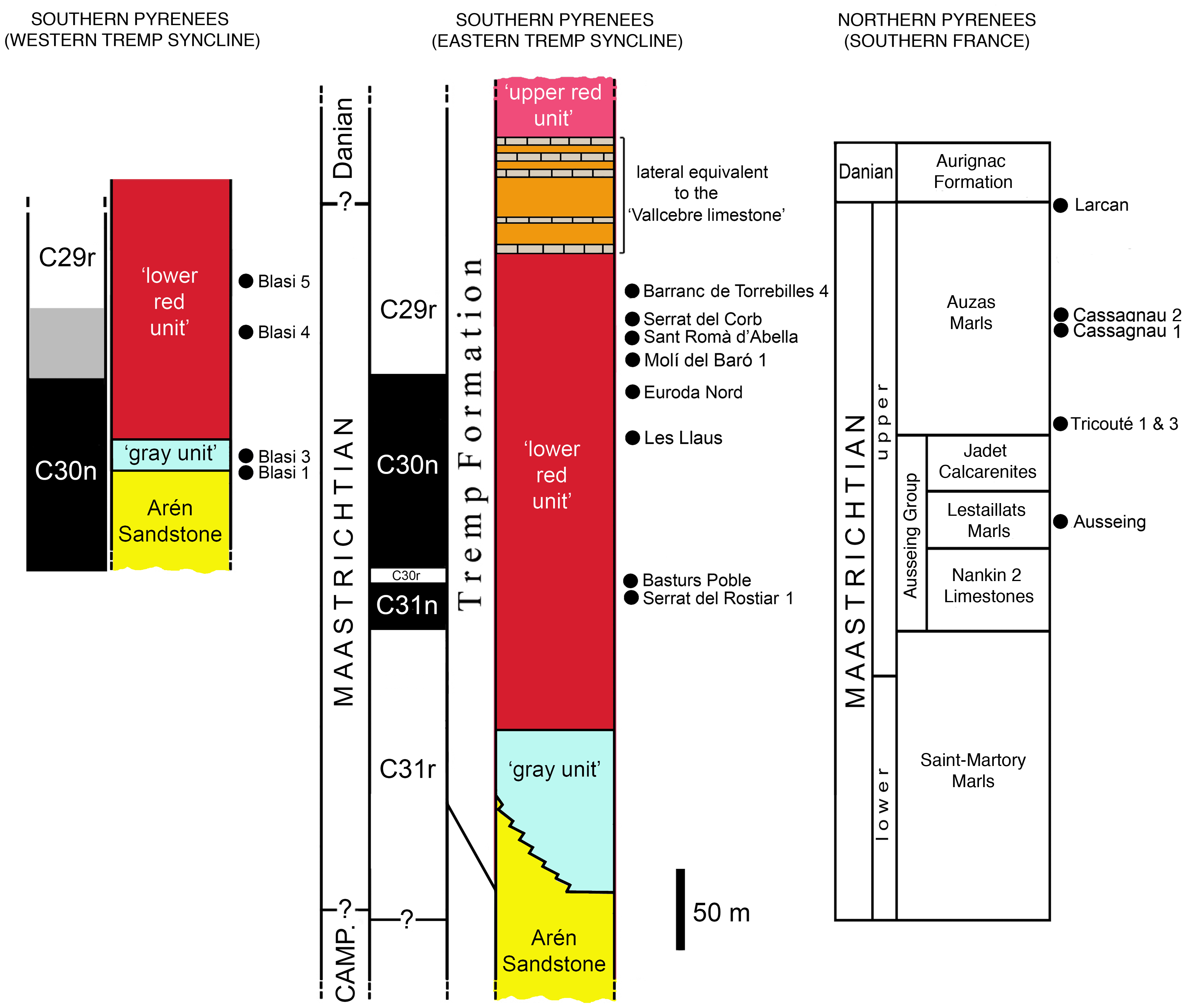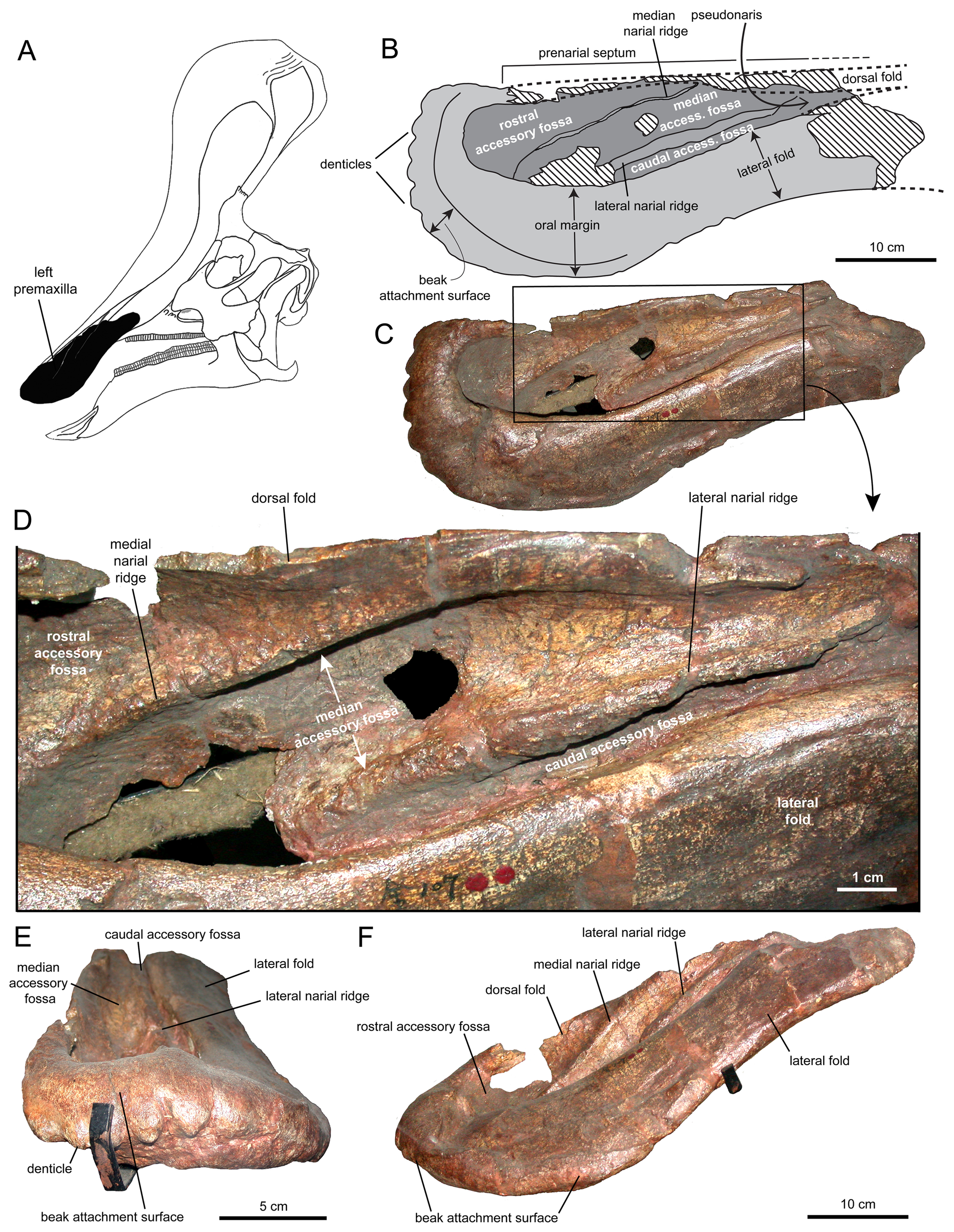|
Blasisaurus
''Blasisaurus'' is a genus of lambeosaurine hadrosaurid dinosaur from the Late Cretaceous. It is known from a partial skull and skeleton found in late Maastrichtian-age rocks of Spain. The type species is ''Blasisaurus canudoi'', described in 2010 by Penélope Cruzado-Caballero, Xabier Pereda-Suberbiola and José Ignacio Ruiz-Omeñaca, a group of researchers from Spain. Naming and discovery The generic name refers to the ''Blasi 1'' site where the fossil was found. The specific epithet honours paleontologist José Ignacio Canudo. The holotype, MPZ99/667, is housed in Huesca. It was found in a layer of the Arén Formation dating from the upper Maastrichtian, about 66 million years ago. It consists of a skull with fragmentary lower jaws. Description ''Blasisaurus'' was a medium-sized ornithopod. Its describers identified two distinct features: the cheekbone has a rear projection with a hook-shaped upper edge and the lower sleep window is narrow and D-shaped. From the same forma ... [...More Info...] [...Related Items...] OR: [Wikipedia] [Google] [Baidu] |
Arenysaurini
Arenysaurini is a proposed tribe of primitive lambeosaurine hadrosaurs. It is composed of genera found in Europe and North Africa during the end of the Cretaceous period, and has been suggested to unite all lambeosaurs from the former continent into a singular monophyletic group. Description Hadrosaurs were a group of herbivorous dinosaurs capable of walking on two or four legs, possessing beaks and complex batteries of teeth; members of Arenysaurini, being of the lambeosaurine lineage of Hadrosauridae, would have possessed large crests on their skulls made up of arrays of nasal passages. Multiple anatomical traits of the skull and teeth unite some or all potential members of Arenysaurini; a mixture of traits seen in primitive and derived lambeosaurs is observed. Examples of primitive traits include a short and a broad dorsal process (bony production) on the maxilla, reduced extensively in derived lambeosaurs. Additionally, several traits distinguish arenysaurs from other lambeos ... [...More Info...] [...Related Items...] OR: [Wikipedia] [Google] [Baidu] |
Pararhabdodon Isonensis
''Pararhabdodon'' (meaning "near fluted tooth" in reference to ''Rhabdodon'') is a genus of tsintaosaurin hadrosaurid dinosaur, from the Maastrichtian-age Upper Cretaceous Tremp Group of Spain. The first remains were discovered from the Sant Romà d’Abella fossil locality and assigned to the genus ''Rhabdodon'', and later named as the distinct species ''Pararhabdodon isonensis'' in 1993. Known material includes assorted postcranial remains, mostly vertebrae, as well as from the skull. Specimens from other sites, including remains from France, a maxilla previously considered the distinct taxon ''Koutalisaurus kohlerorum'', an additional maxilla from another locality, the material assigned to the genera ''Blasisaurus'' and ''Arenysaurus'', and the extensive Basturs Poble bonebed have been considered at different times to belong to the species, but all of these assignments have more recently been questioned. It was one of the last non-avian dinosaurs known from the fossil record th ... [...More Info...] [...Related Items...] OR: [Wikipedia] [Google] [Baidu] |
Hadrosauridae
Hadrosaurids (), or duck-billed dinosaurs, are members of the ornithischian family Hadrosauridae. This group is known as the duck-billed dinosaurs for the flat duck-bill appearance of the bones in their snouts. The ornithopod family, which includes genera such as ''Edmontosaurus'' and ''Parasaurolophus'', was a common group of herbivores during the Late Cretaceous Period. Hadrosaurids are descendants of the Upper Jurassic/Lower Cretaceous iguanodontian dinosaurs and had a similar body layout. Hadrosaurs were among the most dominant herbivores during the Late Cretaceous in Asia and North America, and during the close of the Cretaceous several lineages dispersed into Europe, Africa, South America and Antarctica. Like other ornithischians, hadrosaurids had a predentary bone and a pubic bone which was positioned backwards in the pelvis. Unlike more primitive iguanodonts, the teeth of hadrosaurids are stacked into complex structures known as dental batteries, which acted as effective g ... [...More Info...] [...Related Items...] OR: [Wikipedia] [Google] [Baidu] |
Lambeosaurini
Lambeosaurini, previously known as Corythosaurini, is one of four tribes of hadrosaurid ornithopods from the family Lambeosaurinae. It is defined as all lambeosaurines closer to ''Lambeosaurus lambei'' than to ''Parasaurolophus walkeri, Tsintaosaurus spinorhinus, or Aralosaurus tuberiferus'', which define the other three tribes. Members of this tribe possess a distinctive protruding cranial crest. Lambeosaurins walked the earth for a period of around 12 million years in the Late Cretaceous, though they were confined to regions of modern-day North America and Asia. History of classification The term Corythosaurini was first used by Brett-Surman in 1989, who characterized the taxon via reference to the premaxilary expansion into a hollow helmet-like cranial crest, as well as higher neural spines. The clade was formally defined via phylogenetic analysis by Evans and Reisz in 2007, and this was confirmed by multiple other analyses. In 2011, Sullivan ''et al.'' observed that by the r ... [...More Info...] [...Related Items...] OR: [Wikipedia] [Google] [Baidu] |
Amurosaurus Riabinini
''Amurosaurus'' (; "Amur lizard") is a genus of lambeosaurine hadrosaurid dinosaur found in the latest Cretaceous period (66 million years ago)Godefroit, P., Lauters, P., Van Itterbeeck, J., Bolotsky, Y. and Bolotsky, I.Y. (2011). "Recent advances on study of hadrosaurid dinosaurs in Heilongjiang (Amur) River area between China and Russia." ''Global Geology'', 2011(3). of eastern Asia. Fossil bones of adults are rare, but an adult would most likely have been at least long. According to Gregory S. Paul, it was about long and weighed about . Discovery and naming Russian paleontologists Yuri Bolotsky and Sergei Kurzanov first described and named this dinosaur in 1991. The generic name is derived from the Amur River and the Greek word ''sauros'' ("lizard"). The Amur (called Heilongjiang or "Black Dragon River" in Chinese) forms the border of Russia and China, and is near where this dinosaur's remains were found. There is one known species (''A. riabinini''), named in h ... [...More Info...] [...Related Items...] OR: [Wikipedia] [Google] [Baidu] |
Hadrosaurid
Hadrosaurids (), or duck-billed dinosaurs, are members of the ornithischian family Hadrosauridae. This group is known as the duck-billed dinosaurs for the flat duck-bill appearance of the bones in their snouts. The ornithopod family, which includes genera such as ''Edmontosaurus'' and '' Parasaurolophus'', was a common group of herbivores during the Late Cretaceous Period. Hadrosaurids are descendants of the Upper Jurassic/Lower Cretaceous iguanodontian dinosaurs and had a similar body layout. Hadrosaurs were among the most dominant herbivores during the Late Cretaceous in Asia and North America, and during the close of the Cretaceous several lineages dispersed into Europe, Africa, South America and Antarctica. Like other ornithischians, hadrosaurids had a predentary bone and a pubic bone which was positioned backwards in the pelvis. Unlike more primitive iguanodonts, the teeth of hadrosaurids are stacked into complex structures known as dental batteries, which acted as effectiv ... [...More Info...] [...Related Items...] OR: [Wikipedia] [Google] [Baidu] |
Tsintaosaurus Spinorhinus
''Tsintaosaurus'' (; meaning "Qingdao lizard", after the old transliteration "Tsingtao") is a genus of hadrosaurid dinosaur from China. It was about long and weighed . The type species is ''Tsintaosaurus spinorhinus'', first described by Chinese paleontologist C. C. Young in 1958. A hadrosaur, ''Tsintaosaurus'' had a characteristic 'duck bill' snout and a battery of powerful teeth which it used to chew vegetation. It usually walked on all fours, but could rear up on its hind legs to scout for predators and flee when it spotted one. Like other hadrosaurs, ''Tsintaosaurus'' probably lived in herds. Discovery and naming In 1950, at Hsikou, near Chingkangkou, in Laiyang, Shandong, in the eastern part of China, various remains of large hadrosaurids were uncovered. In 1958 these were described by Chinese paleontologist Yang Zhongjian ("C.C. Young") as the type species ''Tsintaosaurus spinorhinus''. The generic name is derived from the city of Qingdao, earlier often transliterat ... [...More Info...] [...Related Items...] OR: [Wikipedia] [Google] [Baidu] |
Aralosaurus Tuberiferus
''Aralosaurus'' was a genus of hadrosaurid dinosaur that lived during the Late Cretaceous in what is now Kazakhstan. It is known only by a posterior half of a skull (devoid of its mandible) and some post-cranial bones found in the Bostobe Formation in rocks dated from the Upper Santonian-Lower Campanian boundary, at about 83.6 Ma (millions of years). Only one species is known, ''Aralosaurus tuberiferus'', described by Anatoly Konstantinovich Rozhdestvensky in 1968. The genus name means Aral Sea lizard, because it was found to the northeast of the Aral Sea. The specific epithet ''tuberiferus'' means bearing a tuber because the posterior part of the nasal bone rises sharply in front of the orbits like an outgrowth. ''Aralosaurus'' was originally reconstituted with a nasal arch similar to that of North American ''Kritosaurus'' (a comparison based on a specimen now placed in the genus ''Gryposaurus''). For many years, ''Aralosaurus'' was thus placed in the clade of the Hadrosaurinae. T ... [...More Info...] [...Related Items...] OR: [Wikipedia] [Google] [Baidu] |
Koutalisaurus
''Koutalisaurus'' (meaning "spoon lizard", in reference to the shape of the dentary) is a potentially dubious genus of extinct hadrosaurid dinosaur from the Arenysaurini. It is based on a mostly complete dentary from the Maastrichtian-age Upper Cretaceous Tremp Formation near the town of Abella de la Conca, Lleida, Spain. Discovery and naming The holotype dentary, IPS SRA 27, had previously been referred to ''Pararhabdodon'' in 1999,Casanovas, M.L, Pereda-Suberbiola, X., Santafé, J.V., and Weishampel, D.B. (1999). First lambeosaurine hadrosaurid from Europe: palaeobiogeographical implications. ''Geological Magazine'' 136(2):205-211. but comes from a different locality, is based on non-comparable material, and has unusual characteristics, leading Prieto-Marquez ''et al.'' (2006) to place the dentary in the new species ''Koutalisaurus kohleorum''.Prieto-Marquez, A., Gaete, R., Rivas, G., Galobart, Á., and Boada, M. (2006). Hadrosauroid dinosaurs from the Late Cretaceous of Spain ... [...More Info...] [...Related Items...] OR: [Wikipedia] [Google] [Baidu] |
Lambeosaurine
Lambeosaurinae is a group of crested hadrosaurid dinosaurs. Classification Lambeosaurines have been traditionally split into the tribes or clades Parasaurolophini ('' Parasaurolophus'', ''Charonosaurus'', others (?).) and Lambeosaurini (''Corythosaurus'', ''Hypacrosaurus'', ''Lambeosaurus'', others.). Corythosaurini (synonym of Lambeosaurini, see below) and Parasaurolophini as terms entered the formal literature in Evans and Reisz's 2007 redescription of ''Lambeosaurus magnicristatus''. Corythosaurini was defined as all taxa more closely related to ''Corythosaurus casuarius'' than to ''Parasaurolophus walkeri'', and Parasaurolophini as all those taxa closer to ''P. walkeri'' than to ''C. casuarius''. In this study, ''Charonosaurus'' and ''Parasaurolophus'' are parasaurolophins, and ''Corythosaurus'', ''Hypacrosaurus'', ''Lambeosaurus'', ''Nipponosaurus'', and ''Olorotitan'' are corythosaurins. However, later researchers pointed out that due to the rules of priority set forth ... [...More Info...] [...Related Items...] OR: [Wikipedia] [Google] [Baidu] |
Lambeosaurinae
Lambeosaurinae is a group of crested hadrosaurid dinosaurs. Classification Lambeosaurines have been traditionally split into the tribes or clades Parasaurolophini (''Parasaurolophus'', ''Charonosaurus'', others (?).) and Lambeosaurini (''Corythosaurus'', ''Hypacrosaurus'', ''Lambeosaurus'', others.). Corythosaurini (synonym of Lambeosaurini, see below) and Parasaurolophini as terms entered the formal literature in Evans and Reisz's 2007 redescription of ''Lambeosaurus magnicristatus''. Corythosaurini was defined as all taxa more closely related to ''Corythosaurus casuarius'' than to ''Parasaurolophus walkeri'', and Parasaurolophini as all those taxa closer to ''P. walkeri'' than to ''C. casuarius''. In this study, ''Charonosaurus'' and ''Parasaurolophus'' are parasaurolophins, and ''Corythosaurus'', ''Hypacrosaurus'', ''Lambeosaurus'', ''Nipponosaurus'', and ''Olorotitan'' are corythosaurins. However, later researchers pointed out that due to the rules of priority set forth b ... [...More Info...] [...Related Items...] OR: [Wikipedia] [Google] [Baidu] |
Tsintaosaurus
''Tsintaosaurus'' (; meaning "Qingdao lizard", after the old transliteration "Tsingtao") is a genus of hadrosaurid dinosaur from China. It was about long and weighed . The type species is ''Tsintaosaurus spinorhinus'', first described by Chinese paleontologist C. C. Young in 1958. A hadrosaur, ''Tsintaosaurus'' had a characteristic 'duck bill' snout and a battery of powerful teeth which it used to chew vegetation. It usually walked on all fours, but could rear up on its hind legs to scout for predators and flee when it spotted one. Like other hadrosaurs, ''Tsintaosaurus'' probably lived in herds. Discovery and naming In 1950, at Hsikou, near Chingkangkou, in Laiyang, Shandong, in the eastern part of China, various remains of large hadrosaurids were uncovered. In 1958 these were described by Chinese paleontologist Yang Zhongjian ("C.C. Young") as the type species ''Tsintaosaurus spinorhinus''. The generic name is derived from the city of Qingdao, earlier often transliterat ... [...More Info...] [...Related Items...] OR: [Wikipedia] [Google] [Baidu] |







